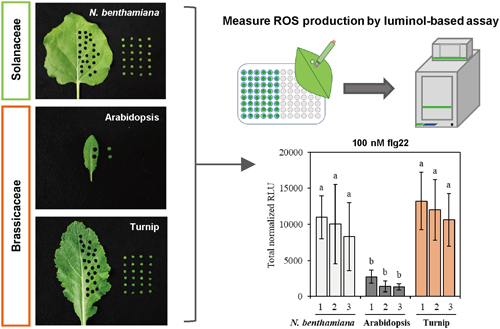- 著者
- Lalita Jantean Kentaro Okada Yaichi Kawakatsu Ken-ichi Kurotani Michitaka Notaguchi
- 出版者
- Japanese Society for Plant Biotechnology
- 雑誌
- Plant Biotechnology (ISSN:13424580)
- 巻号頁・発行日
- vol.39, no.4, pp.415-420, 2022-12-25 (Released:2022-12-25)
- 参考文献数
- 28
Reactive oxygen species (ROS) are critical for plant biological processes. As signaling molecules, ROS regulate plant growth and development through cell expansion, elongation, and programmed cell death. Furthermore, ROS production is induced by microbe-associated molecular patterns (MAMPs) treatment and biotic stresses, and contributes to plant resistance to pathogens. Thus, MAMP-induced ROS production has been an indicator for plant early immune responses or stress responses. One of widely used methods for the measurement is a luminol-based assay to measure extracellular ROS production with a bacterial flagellin epitope (flg22) as a MAMP elicitor. Nicotiana benthamiana is susceptible to a wide variety of plant pathogenic agents and therefore commonly used for ROS measurements. On the other hand, Arabidopsis thaliana, many of genetical lines of which are available, is also conducted to ROS measurements. Tests in an asterid N. benthamiana and a rosid A. thaliana can reveal conserved molecular mechanisms in ROS production. However, the small size of A. thaliana leaves requires many seedlings for experiments. This study examined flg22-induced ROS production in another member of the Brassicaceae family, Brassica rapa ssp. rapa (turnip), which has large and flat leaves. Our experiments indicated that 10 nM and 100 nM flg22 treatments induced high ROS levels in turnip. Turnip tended to have a lower standard deviation in multiple concentrations of flg22 treatment. Therefore, these results suggested that turnip can be a good material from the rosid clade for ROS measurement.
